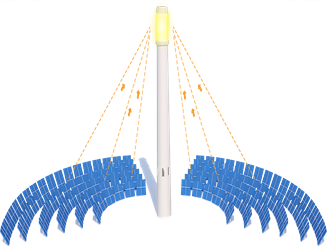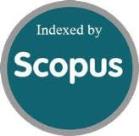Centralized Photovoltaic Heliostat Field Layout and Optical Perception Optimization Based on Improved Dung Beetle Optimization Algorithm
DOI:
https://doi.org/10.46604/ijeti.2024.13683Keywords:
heliostat field, dung beetle optimization algorithm, crossover strategy, random walk strategyAbstract
The gradual depletion of fossil fuels underscores the pressing need for technological advancements in renewable energy. These technologies are essential to address the inefficiencies in power generation from heliostat fields. This paper proposes an innovative heliostat field layout model aimed at significantly enhancing the efficiency of photovoltaic power generation. By carefully optimizing the positioning, height, and size of the heliostats, the model results in a substantial increase in annual heat output. Additionally, an improved Dung Beetle optimization algorithm (RCDBO) is introduced, which integrates random walk and cross strategy to enhance solving efficiency and accuracy while effectively avoiding premature convergence. Simulations demonstrate that the proposed algorithm achieves a 3% increase in efficiency compared to the traditional DBO algorithm, confirming the superiority of the RCDBO algorithm.
References
N. C. Giri, S. Das, D. Pant, V. S. Bhadoria, D. P. Mishra, G. Mahalik, et al., “Access to Solar Energy for Livelihood Security in Odisha, India,” Signals, Machines, and Automation, Springer Nature, pp. 235-242,2022.
B. Wang, Y. Liu, D. Wang, C. Song, Z. Fu, and C. Zhang, “A Review of the Photothermal-Photovoltaic Energy Supply System for Building in Solar Energy Enrichment Zones,” Renewable and Sustainable Energy Reviews, vol. 191, article no. 114100, March 2024.
N. C. Giri, K. K. Shah, S. S. Ray, H. Vennila, S. Das, Y. B. Sandhya, et al., “Photovoltaic Pumping System vs. Livelihoods and Sustainability,” Ambient Science, vol. 9, no. 1, pp. 27-30, January 2022.
T. Arrif, A. Sánchez-González, B. Bezza, and A. Belaid, “Shadowing and Blocking Factors in Heliostats: Comparison between Parallel and Oblique Projections,” SOLARPACES 2020: 26th International Conference on Concentrating Solar Power and Chemical Energy Systems, AIP Publishing, vol. 2445, no. 1, article no. 120004, May 2022.
B. Gao, H. Sun, and S. Liu, “Heliostat Field Layout Optimization of Solar Tower Power Station Based on Improved Whale Algorithm,” Acta Energiae Solaris Sinica, no. 10, pp. 209-217, 2023.
Y. Zou, Y. Zhou, and Q. Xu, “Heliostat Field Layout via Niching and Elite Competition Swarm Optimization,” IEEE Access, vol. 12, pp. 31589-31604, 2024.
T. Arrif, S. Hassani, M. Guermoui, A. Sánchez-González, R. A. Taylor, and A. Belaid, “GA-GOA Hybrid Algorithm and Comparative Study of Different Metaheuristic Population-Based Algorithms for Solar Tower Heliostat Field Design,” Renewable Energy, vol. 192, pp. 745-758, June 2022.
L. Pisani, G. S. Moreau, E. Leonardi, C. Podda, A. Mameli, and G. Cao, “Multi-tower Heliostat Field Optimization by Means of Adiabatic Quantum Computer,” Solar Energy, vol. 263, article no. 111893, October 2023.
B. K. Reddy, N. C. Giri, P. K. Yemula, E. B. Agyekum, and Y. Arya, “Optimal Operation of Cogeneration Power Plant Integrated with Solar Photovoltaics Using DLS‐WMA and ANN,” International Journal of Energy Research, vol. 2024, no. 1, article no. 5562804, 2024.
D. Yadav, N. Singh, N. C. Giri, V. S. Bhadoria, and S. K. Sarker, “Comparison of Bioinspired Techniques for Tracking Maximum Power under Variable Environmental Conditions,” International Journal of Intelligent Systems, vol. 2024, no. 1, article no. 6678384, 2024.
M. Haris, A.U. Rehman, S. Iqbal, S. O. Athar, H. Kotb, K. M. Aboras, et al., “Genetic Algorithm Optimization of Heliostat Field Layout for the Design of a Central Receiver Solar Thermal Power Plant,” Heliyon, vol. 9, no. 11, article no. e21488, November 2023.
Y. Wang and D. Ni, “Real-Time Aiming Strategy Optimization of Heliostat Field of Solar Power Tower via a Modified PSO Algorithm (SPSO),” 2023 China Automation Congress (CAC), IEEE, pp. 368-373, 2023.
S. Wang, C.-A. Asselineau, A. Fontalvo, Y. Wang, W. Logie, J. Pye, et al., “Co-optimization of the Heliostat Field and Receiver for Concentrated Solar Power Plants,” Applied Energy, vol. 348, article no. 121513, October 2023.
Q. Xie, Z. Guo, D. Liu, Z. Chen, Z. Shen, and X. Wang, “Optimization of Heliostat Field Distribution Based on Improved Gray Wolf Optimization Algorithm,” Renewable Energy, vol. 176, pp. 447-458, October 2021.
R. Conceição, A. M. Hernández, M. Romero, and J. González-Aguilar, “Experimental Soiling Assessment, Characterization and Modelling of a Highly-Compact Heliostat Field in an Urban Environment,” Solar Energy, vol. 262, article no. 111812, September 2023.
K. Xu, H. Xu, and J. Fan, “Research on Optimization Model Based on Heliostat Field,” Highlights in Science, Engineering and Technology, vol. 82, pp. 99-107, 2024.
H. Li, R. Zhang, C. Liu, and J. Yin, “Optimized Design of Heliostat Field Efficiency Based on Finite Element Analysis Method,” Proceedings of 2024 IEEE 3rd International Conference on Electrical. Engineering, Big Data Algorithms (EEBDA), IEEE, pp. 1371-1376, 2024.
J. Xue and B. Shen, “Dung Beetle Optimizer: A New Meta-Heuristic Algorithm for Global Optimization,” The Journal of Supercomputing, vol. 79, no. 7, pp. 7305-7336, May 2023.
M. Guermoui, T. Arrif, A. Belaid, S. Hassani, N. Bailek, “Enhancing Direct Normal Solar Irradiation Forecasting for Heliostat Field Applications Through a Novel Hybrid Model,” Energy Conversion and Management, vol. 304, article no. 118189, March 2024.
I. Paul and S. B. Kedare, “Determination of Optically Feasible Heliostat Field Region for Solar Power Tower System Employing Innovative Receiver Aperture,” Solar Energy, vol. 271, article no. 112404, March 2024.
F. A. Hashim, E. H. Houssein, K. Hussain, M. S. Mabrouk, and W. Al-Atabany, “Honey Badger Algorithm: New metaheuristic algorithm for solving optimization problems,” Mathematics and Computers in Simulation, vol. 192, pp. 84-110, February 2022.

Published
How to Cite
Issue
Section
License
Copyright (c) 2024 Bin Liu, Chengyu Jiang, Biguang Kong, Jiayu Wu, Junwei Yang

This work is licensed under a Creative Commons Attribution-NonCommercial 4.0 International License.
Copyright Notice
Submission of a manuscript implies: that the work described has not been published before that it is not under consideration for publication elsewhere; that if and when the manuscript is accepted for publication. Authors can retain copyright in their articles with no restrictions. Also, author can post the final, peer-reviewed manuscript version (postprint) to any repository or website.

Since Jan. 01, 2019, IJETI will publish new articles with Creative Commons Attribution Non-Commercial License, under Creative Commons Attribution Non-Commercial 4.0 International (CC BY-NC 4.0) License.
The Creative Commons Attribution Non-Commercial (CC-BY-NC) License permits use, distribution and reproduction in any medium, provided the original work is properly cited and is not used for commercial purposes.







.jpg)


